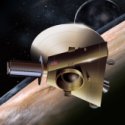Recent observations show Pluto's atmosphere has changed significantly over the past 14 years. A recent occultation of a star by Pluto confirms suspicions that the faraway planet's atmosphere changes during its 248-year journey about the sun. The new data also suggests that the changes are even more drastic than imagined. Similar to
the moon passing in front of the sun during a solar eclipse, a solar system
object passes in front of a star during an occultation. If the object has
an atmosphere, astronomers can scrutinize the star's light just before and
just after the object begins to blot out the starlight. Careful
observations can reveal details about the atmosphere's density, temperature,
and pressure. |
||
"In the last 19 years, one or more changes have occurred," Buie reports. "Pluto's atmosphere is undergoing global cooling, while other data indicate that the surface seems to be getting slightly warmer. Some change is inevitable as Pluto moves away from the sun, but what we're seeing is more complex than expected." From the earlier occultation and other observations, planetary scientists learned that Pluto has a delicate atmosphere with nitrogen and some methane and carbon dioxide. In 1988, the occulted star's light dipped slightly at first before plunging sharply. The unexpected behavior suggested Pluto's atmosphere could have a smog layer or a sudden drop in temperature near the planet's surface.
In contrast, the July occultation provided a much smoother light curve, suggesting the cause of the abrupt drop witnessed in 1988 is no longer present. Additionally, the recent results show that Pluto's atmosphere has cooled between 20 and 55 degrees Fahrenheit. "A 1997 Triton occultation revealed that the surface of Triton, Neptune's largest moon, had warmed since the Voyager spacecraft first explored the moon in 1989," Elliot says. "But the changes observed in Pluto's atmosphere are much more severe. We cannot fully explain what has caused these dramatic changes to Pluto's atmosphere," Buie adds. "The Pluto-Kuiper Belt mission is our best hope for putting all the puzzle pieces together." |
||
For years, NASA has included a spacecraft to Pluto in its plans, but budget problems have repeatedly scrapped or delayed the mission. Finally, the New Horizons mission to Pluto launched on January 19, 2006. It will reach Pluto around July, 2015.
|


